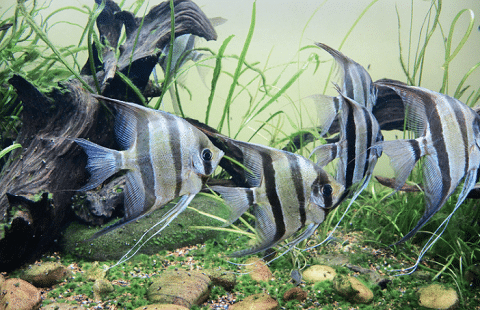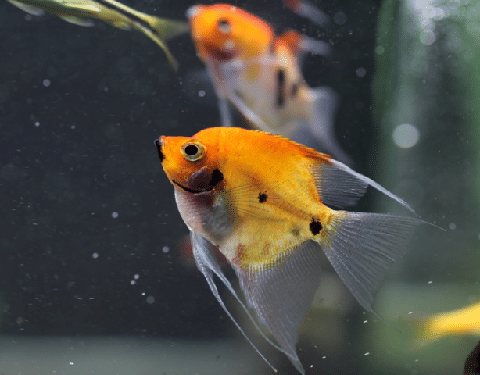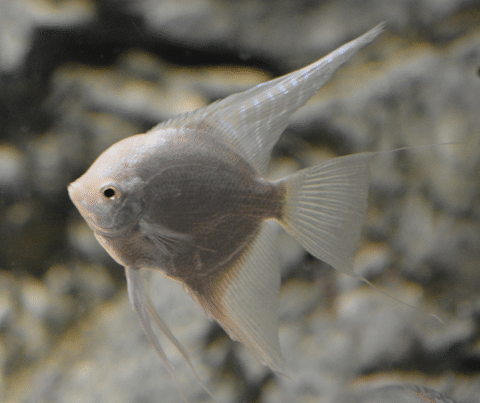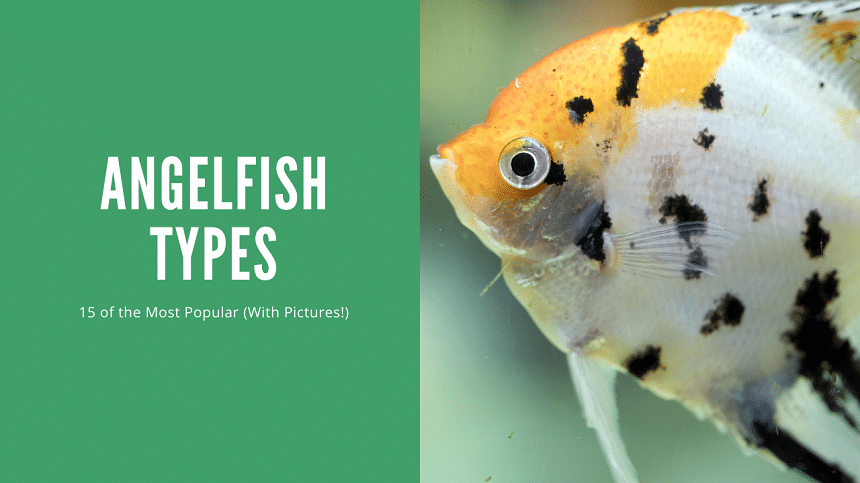Thank you for visiting! By the way… any links on this page that lead to products on Amazon and other stores/partners are affiliate links Aquarium Store Depot earns a commission if you make a purchase.
Freshwater angelfish are one of the most common and popular aquarium fish in the hobby. You only have to look at them to see why! These beautiful fish for freshwater aquariums have a distinctive body shape and great colors and markings.
Many fish keepers will be surprised to know that there is a huge variety of different types of angelfish with amazing patterns and colors available, and that’s just what this article is about.
Read on to learn about 15 different types of these angelic tropical fish and get some great advice on how to care for them too!
What Is An Angelfish?
Freshwater angelfish are South American cichlids of the Pterophyllum genus. These graceful and elegant fish are relatively peaceful as far as cichlids go, and are popular as community fish for home aquariums.
Angelfish are hardy tropical fish that can live as long as a decade in a well-maintained fish tank. These fish have been captive-bred in the aquarium hobby for generations and are available in an amazing variety of different breeds today.
There are 3 wild species of freshwater angelfish known in the freshwater aquarium hobby:
- Common angelfish- Pterophyllum scalare
Most of the angelfish found in the aquarium trade are varieties of this species.
- Altum angelfish- Pterophyllum altum
This large species is seen less often but is pretty well known in the hobby.
- Leopold’s angelfish- Pterophyllum leopoldi
The last species is very rare in the hobby, but is the smallest of the three and does very well in aquariums.
15 Angelfish Types for your aquarium
Now that you know a little more about these popular tropical fish, it’s time to dive right in and get to know some of the best types that you can keep in your own fish tank.
For each type, I’ll be providing some important information like:
- Which species they are
- Their size when fully grown
- How they look and what makes them unique
Check out our YouTube video below from our channel. We go into further detail in our blog. Give us a sub if you like our content!
So let’s get started!
1. Altum

- Angelfish Species: Pterophyllum altum
- Adult Size: 7 inches long, 10 inches deep
- Color: Silver, gold, and black
- Unique Traits: Largest angelfish
The altum angelfish is a relatively rare species that is larger and deeper-bodied than the more common aquarium varieties. They are also known as the Orinoco angelfish after one of the South American rivers where they are found.
These angelic fish look amazing and usually have silver coloration with only three stripes. They are a great choice for more experienced aquarists because they are a challenging but rewarding species to keep.
2. Koi Angel-Fish

- Angelfish Species: Pterophyllum scalare
- Adult Size: 6 inches long, 8 inches deep
- Color: White, yellow/orange, black
- Unique Traits: Tricolor with unique markings
The koi angelfish is one of the most popular types of angelfish and it is easy to see why! Each koi angelfish is unique which makes them highly sought after, and often more expensive.
This variant typically has three colors (tricolor) like the Asian koi carp. These colors are white, black, and golden orange/yellow. Koi angelfish are eyecatching fish that make a great centerpiece fish in community aquariums.
3. Panda
- Angelfish Species: Pterophyllum scalare
- Adult Size: 6 inches long, 8 inches deep
- Color: Black and white
- Unique Traits: Variably marked in black and white
The panda angelfish (video source) is a bold variant of the popular angelfish. These black and white angelfish can have various markings, making each individual unique.
4. Albino Dantum
- Angelfish Species: Pterophyllum sp.
- Adult Size: 6 inches long, 8 inches deep
- Color: White
- Unique Traits: Tall body and long fins
Albino dantum angelfish (LFS Source) are another amazing angelfish breed. These fish have red eyes and visible, but uncolored vertical stripes. The exact species of the breed is unknown, and they might even be a hybrid between two different species.
5. Fluorescent
- Angelfish Species: Pterophyllum scalare
- Adult Size: 6 inches long, 8 inches deep
- Color: Pink
- Unique Traits: Bright, fluorescent color
The fluorescent angelfish (video source) is a genetically modified breed. These fish are very rare and were first developed by researchers in Taiwan. One thing is for certain though, these pink angels are the most colorful angelfish breed in the hobby!
6. Chocolate Angelfish
- Angelfish Species: Pterophyllum scalare
- Adult Size: 6 inches long, 8 inches deep
- Color Pattern: Brown and silver
- Unique Traits: Dark body and silvery head
Chocolate angelfish (video source) have a dark pigmentation that usually begins just behind the gills and covers most of the body. Their heads are typically silvery grey in color. This bold breed often has grey patches on the dark chocolate-colored sides of the body.
7. Platinum

- Angelfish Species: Pterophyllum scalare
- Adult Size: 6 inches long, 8 inches deep
- Color: Silvery white
- Unique Traits: Solid/ Uniform
The platinum angelfish is a dazzling breed with all-white coloration. These fish are not albino, however, and have black eyes.
Platinum angelfish really stand out in a tank with good lighting and a dark background.
8. Leopard

- Angelfish Species: Pterophyllum scalare
- Adult Size: 6 inches long, 8 inches deep
- Color: Black and golden yellow
- Unique Traits: Variable markings
The leopard angelfish is a breed that has very variable markings. The spotted coloration of the leopard angelfish is most obvious when the fish are young and reared in good lighting. The markings often merge into a solid dark color as the fish mature.
9. Veiltail
- Angelfish Species: Pterophyllum scalare
- Adult Size: 6 inches long, 8 inches deep
- Color: Variable
- Unique Traits: Long, flowing fins
Veiltail or veil angelfish are bred for their wonderful flowing fins. These angelic fish come in a variety of different colors and patterns.
They are a little clumsier than regular finned breeds so they do better in tanks with a slow water flow. They should also not be housed with any tank mates that might want to nip at their incredible finnage.
10. Ghost
- Angelfish Species: Pterophyllum scalare
- Adult Size: 6 inches long, 8 inches deep
- Color: Variable
- Unique Traits: Stripeless sides
Ghost angelfish (video source) have genetics that prevents them from developing the bold stripes of typical angelfish. They usually have a silver body, but darker variants like the black ghost are also available.
11. Gold

- Angelfish Species: Pterophyllum scalare
- Adult Size: 6 inches long, 8 inches deep
- Color: Golden
- Unique Traits: Stripeless
Gold angelfish have a solid pale golden color over their entire body. This breed has been in the aquarium trade since the 1960s when they were first accidentally bred. Gold angelfish show the most color towards the top of the head and have no black coloration.
12. Albino

- Angelfish Species: Pterophyllum scalare
- Adult Size: 6 inches long, 8 inches deep
- Color: Pink/white
- Unique Traits: No pigment and pink/red eyes
Albino angelfish have no pigment and therefore have a whitish pink overall coloration and distinctive pink/red eyes. While albino angelfish are very unusual and interesting, they tend to be less hardy than naturally colored forms.
13. Black

- Angelfish Species: Pterophyllum scalare
- Adult Size: 6 inches long, 8 inches deep
- Color: Black
- Unique Traits: Dark body and red eyes
Black angelfish are almost completely black, and usually do not have any white pigmentation. This dramatic-looking breed typically has red eyes which stand out against their dark body color.
14. Blue
- Angelfish Species: Pterophyllum scalare
- Adult Size: 6 inches long, 8 inches deep
- Color: Blue and silver
- Unique Traits: Blue color
The blue angelfish is a beautiful breed that has a powdery blue tint to its silvery body. The verticle black bars may be fainter in fish with the blue gene than in other breeds, but will usually still be visible.
15. Redcap
- Angelfish Species: Pterophyllum scalare
- Adult Size: 6 inches long, 8 inches deep
- Color: silvery-white and orange
- Unique Traits: Red head cap
The redcap angelfish (video source) is a distinctive breed with a white body and orange ‘cap’. The orange coloration extends roughly from the fish’s mouth to the start of the dorsal fin.
Some Other Popular Varieties
- Marble angelfish
- Zebra angelfish
- Black lace angelfish
- Silver angelfish
- Blushing angelfish
- Smokey angelfish
Tank Setup
Before setting up a tank for any fish, it is important to know a little about their natural habitat.
Freshwater angelfish are native to several countries in South America where they occur in slow-moving, acidic water that is rich in aquatic vegetation and leaf litter.
With this in mind, let’s take a look at how to set up an awesome angelfish aquarium!
Tank Size
Angelfish are medium-sized fish that need a fairly large aquarium. Although they may look small when sold as juveniles at the pet store, they will grow to about the size of a saucer.
The minimum tank size for a small group of these amazing fish is 29 gallons, but a 55-gallon tank or larger would be a better option. Choose a deep tank that will give these tall fish plenty of room to move up and down in the water.
Filtration
You will need a good-quality filter to keep your water quality high. The type of filter you select is not too important, and many angelfish keepers rely on simple sponge filters.
Hang-on back and canister filters also work great, and have the benefit of using little or no space in the tank. One important factor to keep in mind is that angelfish do not enjoy strong water flow, so select a filter model with an adjustable flow rate.
The Pro's Choice
The top choice among professional aquascapers. German engineering and equipped with an intregrated heater.
Temperature And Other Important Parameters
Angelfish are tropical fish that prefer warm water temperatures. Temperatures between 78 and 84°F are ideal for these fish. Since most homes won’t run this warm, an investment in an aquarium heater is required.
Unless you live in a tropical climate, you will need to run a heater to keep the water in your tank stable and warm enough.
In nature, these fish are found in slightly acidic water. Most of the angelfish in the aquarium trade are captive-bred fish and are very adaptable to different conditions, however.
Generally speaking, angelfish can be kept in the following water parameters:
- pH: 6.5-7.2
- Ammonia: 0 ppm
- Nitrite: 0 ppm
- Nitrate: <30 ppm
Live Plants And Decorations
Angelfish feel very at home in planted aquariums. They can be kept with most of the common tropical aquarium plants, but be advised, they might nibble the leaves!
This means they aren’t the best choice for carefully aquascaped tanks. If you’re new to growing aquarium plants, the following species are good options because they are tough and easy to care for:
A substrate is not strictly necessary and many aquarists choose keep these fish in a bare bottom tank. For a more natural look, sand or gravel substrates are also good options.
Providing some vertical structure in the tank is another way to make your fish feel more comfortable while improving the aesthetics of your aquarium. Vertically arranged driftwood is great for simulating their natural, flooded riverbank habitat.
How To Care For Your Pet
Angelfish are hardy and relatively easy fish to care for. They are a great choice for beginners, as long as they can be provided with the basic care they need.
Read on to learn how to care for these angelic tropical fish.
Water Quality
The most important requirement for keeping healthy angelfish is to provide them with excellent water quality. Without good filtration and regular maintenance, the water in your tank can quickly become toxic.
Your filter and the beneficial bacteria that colonize it will do a lot of the hard work in maintaining your water quality. You will also have to get your hands wet on a regular basis, however, and perform partial water changes and vacuum the bottom of the tank.
Testing
Testing your water parameters is the simplest way to know whether your water quality is good, and your maintenance schedule is adequate. This is quick and easy to do and should be part of any aquarist’s skill set.
Fortunately, water test kits make this task very easy. I would suggest picking up a master test kit or high quality liquid tests. Whichever test kit you get, make sure you can measure the following parameters:
- pH
- Ammonia
- Nitrite
- Nitrate
Aquarium Maintenance
Aquarium maintenance is a great chance to get hands-on with your tank, and really get a feel for what’s going on in your underwater world. Apart from keeping your freshwater aquarium looking great, regular maintenance is necessary for keeping nitrate levels in the water down to safe levels, and this requires partial water changes.
Freshwater angelfish are relatively hardy, especially if captive-bred. Provided they are kept in an appropriately sized tank, you can probably get away with a small water change once a week, or a larger one every 2nd week.
The volume and frequency of your water changes will be determined largely by the bioload in your tank, and other factors like how heavily you feed your pets. In any case, your test kit will be very helpful in working out how much maintenance is necessary.
Feeding
Angelfish are omnivorous fish that are easy to feed. Cichlid pellets or tropical fish flakes are great options as staple food sources.
To provide your fish with a more balanced diet, be sure to supplement them with live and frozen foods like bloodworms, and boiled/blanched vegetables like peas and zucchini.
You can feed your fish once or twice a day, but be careful to avoid overfeeding. As a general rule do not put more food into the tank than your fish can finish in about 2 minutes.
Tankmates
While your angelfish will be very peaceful towards other species, they can be a little aggressive towards other angelfish of the same species. To minimize aggression, make sure you keep a group of at least 4 or so. This helps to prevent anyone from getting picked on.
You can also keep a single angelfish in a large community tank. When selecting tank mates, be sure to avoid any aggressive species or known fin-nippers like tiger barbs that can damage the long fins of your angels.
Although their mouths are pretty small, it is wise to remember that freshwater angelfish are fairly large community fish and will eat any other fish or shrimp that is small enough for them to swallow.
The following species are all good tankmate options:
- Larger peaceful tetras like the black skirt and congo tetras. Avoid nano tetras like ember tetras
- Bristlenose pleco
- Corydoras catfish
- Clown loaches
No matter which fish you choose to keep with your angels, be sure that they enjoy the same warm water temperature and other parameters.
Breeding
It is possible to breed your angelfish at home. Using a dedicated breeding tank can be very helpful in minimizing losses because angelfish will often feed on their own spawn and fry.
It is very difficult to tell male angelfish from females, so it is best to keep several fish and let them pair up naturally. You would be very unlucky to not have at least one breeding pair from a group of 6-8 angelfish. Alternatively, you may be able to buy an established breeding pair from an experienced breeder.
Conditioning your fish with high-quality, live, or frozen food will increase their chance of spawning. Freshwater angelfish lay eggs on vertical surfaces in the tank, and this could be anything from a plant to the glass walls of the aquarium.
The eggs hatch after just a few days and you can expect hundreds of fry, so make sure you are going to be able to find them all homes before breeding. Hatching your own baby brine shrimp will ensure you have an ideal food source for the little ones.
Health Problems
Unfortunately, freshwater angelfish are sensitive to some common fish diseases. The best way to avoid these issues is to maintain excellent water quality, maintain the correct water parameters, and feed your fish a healthy balanced diet.
Quarantining new fish before introducing them to a community tank is also advisable to prevent the spreading of diseases. Some of the more commonly seen diseases include:
- Hexamita (hole-in-the-head disease)
- Ich
- Columnaris
- Fin rot
Where To Buy
Angelfish are very popular and are usually easy to find at pet stores. Your local pet store will probably stock some of the more popular captive-bred varieties, but for rarer types, online shopping or getting in touch with local breeders might be necessary.
FAQS
What Is The Rarest Freshwater Type?
The clown angelfish is considered to be one of the rarest types of angelfish in the aquarium trade.
How Many Should Be Kept Together?
Angelfish are naturally social, so it is best to keep at least 4 of them in the same tank. It is possible, however, to keep a single angelfish as a centerpiece fish in a community tank.
Do They Eat Other Fish?
Freshwater Angelfish will feed on just about any smaller fish or freshwater aquarium animal that is small enough to fit in their mouths.
This is just the natural and instinctive feeding behavior of wild angelfish, and shouldn’t be seen as aggression.
How Many Times A Day Should You Feed Freshwater Types?
Most angelfish can be fed once or twice per day, although young fish may need more frequent meals.
To avoid overfeeding, make sure your fish are able to finish all the food in one go because uneaten food will spoil and affect the water quality in the tank.
Can You Mix Different Types Together?
You can certainly keep different types of angelfish together in the same fish tank. If you are selective breeding for a specific type of angelfish, this can produce some unwanted results though.
Veil angelfish may be an exception, however. Since they are slower swimmers than other breeds, they may struggle to compete for food and defend themselves against any territorial aggression.
Final Thoughts
With so many different types of angelfish available in the hobby, there’s an angelfish out there to suit just about any tank.
Which is your favorite type of angelfish? Let me know below!
- About the Author
- Latest Posts
I’m thrilled that you found Aquarium Store Depot! Here you’ll find information on fish, aquariums, and all things aquatics related. I’m a hobbyist (being doing this since I was 11) and here to help other hobbyists thrive with their aquariums! I adhere to a high quality Editorial Process and Review products with real life field usage and practical analysis.







I think I just fell in love with Pandas. Thanks for an excellent article
I have two Black Lace Angels, about a year old very beautiful. They have started being aggressive towards the other fish in my 55 gal tank. This morning they were either kissing or fighting each other. They had their mouths stuck together for a good 30 second. and kept up that behavior. Can you tell me whats going on with them?
Hello Juanita. Are your angelfish swimming side by side before kissing or are they chasing each other. If they are swimming side by side they are mating, which would explain their aggressive behavior. Most cichlid types (which an angelfish is) will become more aggressive when breeding. It would be best to remove the mated pair so they can breed or consider removing either one of them.
For a male – they will have a forked front fin and a large circular body. A female with have a small angular body and smooth front fins.